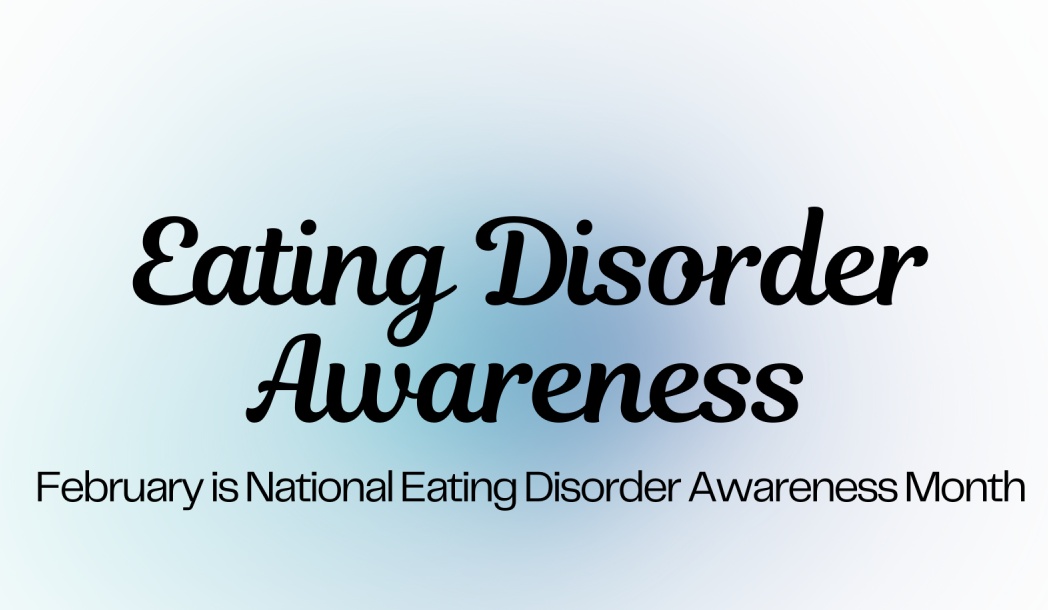Eating Disorder Awareness Month 2025

February marks Eating Disorder Awareness Month, dedicated to shedding light on these complex illnesses that affect people of all ages, genders, backgrounds, and body sizes. As awareness spreads, we move one step closer to understanding eating disorders and supporting those struggling.
Defining Eating Disorders
What exactly are eating disorders? Eating disorders are serious mental illnesses characterized by severe disturbances in eating behaviors and body image. People struggling with eating disorders become preoccupied with food, body weight, or appearance to the point where it damages physical health, emotional stability, and the ability to function in life.
Some common eating disorders include:
Anorexia Nervosa
This disorder involves restricting food intake, leading to dangerous weight loss paired with an intense fear of weight gain or persistent behavior that prevents weight gain. Many individuals with anorexia see themselves as “too fat” even when they are underweight.
Bulimia Nervosa
Characterized by episodes of binge eating followed by purging behaviors like self-induced vomiting to avoid weight gain. People with bulimia can fall within a normal weight range but struggle with the same fear of gaining weight as those with anorexia.
Binge Eating Disorder
Marked by uncontrolled episodes of overeating in which people consume large amounts of food due to feeling out of control and unable to stop. Binging leads to feelings of guilt, embarrassment, and emotional distress, but does not involve purging behaviors.
Why Raise Awareness?
While eating disorders only affect a small percentage of the population, they have the highest mortality rate of any mental illness. Without treatment, eating disorders result in serious health consequences and can even be fatal.
Raising awareness promotes early intervention, reduces stigma around mental health issues, and lets those struggling know they’re not alone on their path to recovery. Think of eating disorder awareness as turning on a flashlight in a dark room – suddenly, the obstacles ahead become visible and navigable.
The more discussions we spark, the more light we cast on these complex illnesses.
Who’s At Risk?
Eating disorders do not discriminate – they transcend gender, age, socioeconomic status, race, and ethnicity. However, certain risk factors can increase susceptibility.
Gender
While eating disorders were once thought to only impact women, recent studies show nearly one-third of cases occur in men. Social pressures tied to the masculine ideal physique contribute to rising rates of eating disorders like anorexia athletica (hyper-focus on fitness and leanness) in young men.
Age & Stage
Eating disorders typically emerge during adolescence and early adulthood, but reports in children under 12 years old are rising. Factors like school transitions, puberty changes, sports involvement, and social pressures can contribute to risk during developmental stages.
Family History
Individuals with first-degree relatives who have had an eating disorder are significantly more likely to develop one. While no specific gene has been identified, heredity likely interacts with environmental influences.
Mental Health Issues
Anxiety disorders, depression, substance abuse, and other psychiatric issues tend to co-occur with eating disorders. Trauma and adverse childhood experiences also correlate with an increased risk.
Warning Signs
Because eating disorders center around secrecy and behaviors that compensate for irregular eating, they can be difficult to spot. Here are some common red flags:
- Strict dieting and denial of hunger
- Obsession with healthy eating and good/bad foods
- Evidence of binge eating, like disappearance or hoarding of large amounts of food
- Use of laxatives, diet pills, or appetite suppressants
- Compulsive or excessive exercise well beyond fitness goals
- Physical signs like bloody knuckles, calluses on the back of fingers or cheeks, tooth enamel erosion, lanugo hair
- Noticeable weight loss, weight gain, or fluctuation
- Preoccupation with weight, body image, or fear of specific foods
- Withdrawing from social activities around food
These warning signs underscore how eating disorders impair quality of life. Time with friends and family becomes limited by secrecy, shame, or compulsive behaviors. Rather than enjoying food and meals, people fear them. Pleasurable movement through sports and activity gets replaced by compulsive exercise.
If you notice any of these persistent behaviors in yourself or a loved one, seek help right away. The earlier the treatment starts, the better the chances of recovery.
Overcoming Stigma
While warning signs can indicate an eating disorder on the horizon, many people hide their struggles well. Why all the secrecy? Eating disorders carry a heavy stigma, which keeps people trapped by feelings of embarrassment, shame, and the belief that they should be able to “get over it”.
Think of the common view of eating disorders as vain, childish pleas for attention regarding a lack of self-control or willpower. People get caught in thinking like “It’s just food, get over it” or “You’re doing this for attention” rather than seeing the seriousness of these mental illnesses.
The reality? Complications from eating disorders can damage vital organs like the heart and brain, whilebecomeg life-threatening. Recovery is difficult work, often requiring intensive treatment.
As awareness spreads, stigma lessens. Challenging misconceptions with compassion allows more people to seek help.
Treatments That Heal
Overcoming an eating disorder means restoring healthy body and self-image perceptions. Treatment aims to address underlying emotional issues through counseling while building coping skills to rewire disordered thoughts and behaviors.
Today, eating disorders have the highest treatment success rates than ever before, thanks to an integrative approach combining:
Psychotherapy
Exploring self-image issues and triggers for eating disorder behaviors occurs in individual, group, and family therapy settings. Cognitive behavioral therapy helps patients challenge destructive thought patterns, while dialectical behavior therapy builds distress tolerance and self-soothing skills.
Nutritional Counseling
Guidance from dietitians helps people recover intuitive eating habits by setting meal plans to restore weight, health, and energy levels. Support groups provide a community for trying new fear foods.
Medical Care
Since eating disorders affect vital organs, ongoing care from doctors allows monitoring of danger signs like electrolyte imbalances, vital sign changes, or bone loss requiring intervention. For severe malnutrition, hospitalization provides stabilization, refeeding protocols, and round-the-clock care.
Psychiatry
As many as 50% of eating disorder cases involve co-occurring psychiatric disorders like depression, anxiety, PTSD, or substance abuse issues. Managing these through counseling and/or medication optimizes recovery success.
Full recovery looks different for everyone,ne but with professional support, restoring hope happens one day at a time.
Encouraging Signs
While every recovery journey has challenges, positive progress serves as the light guiding the way. Here are some empowering milestones:
- Asking for and accepting help
- Establishing a support system
- Improving body image perceptions
- Respecting bodily cues like hunger and fullness
- Tolerating fear foods and situations
- Reducing disordered behaviors
- Engaging in aspects of life unrelated to food, weight, and body image
- Liking yourself for qualities beyond appearance
- Feeling happiness and freedom with just being
Recovering from an eating disorder does not follow a straight path, but every step towards self-acceptance and balance is worth celebrating. Progress illuminates motivation to keep going.
Helping Others
If someone you know shows signs of a possible eating disorder, don’t just stand by. Your support makes a life-saving difference. Here’s how to help while being sensitive to struggles:
Educate Yourself
Read up on eating disorders from reputable sources like the National Eating Disorder Association and understand health risks, treatments, and recovery. Get insight into responding constructively.
Express Concern
Have a heartfelt talk, sharing specific behaviors that seem unusual, along with worries about physical and emotional well-being. Make it about health, not food or weight.
Encourage Professional Help
Suggest making an appointment with a doctor, counselor, or treatment program for an assessment. Offer to help find providers and go to sessions. Listen without judgment.
Foster Connections
Since isolation worsens eating disorders, regularly include your loved one in supportive social activities. Organize outings, avoiding constant food and body image talk.
Getting treatment early and maintaining connections improves recovery outlooks – so reach out right away if you spot any red flags. Continue offering compassionate support over the long haul. Recovery is a winding path with ups and downs, and your encouragement makes more positive strides possible.
Progress Through Awareness
Eating disorders thrive in secrecy. The more voices speaking out, the less shame persists. Awareness equals acceptance, which makes recovery feel within reach.
How can you foster life-changing understanding this Eating Disorder Awareness Month?
Follow EDA organizations on social media to receive news updates as well as shareable facts and stories to heighten awareness. Tag #EDAM when posting.
Support fundraising campaigns benefiting critical research causes and effective treatments. Every dollar makes a difference!
Join an Event like the annual Eating Disorders Coalition Advocacy Day or NEDA NED Awareness Week conferences occurring nationwide to show solidarity.
Share Your Story openly on sites like We Bite Back with details on navigating an eating disorder firsthand. This solidarity helps others feel less alone.
Small actions spark bigger changes towards hope and healing for all touched by these misunderstood illnesses. Through awareness comes the clarity that eating disorders do not define anyone, and integrated treatments can guide the way back to freedom.
The path starts from a single step…who will you light the way for today?
Frequently Asked Questions
What causes eating disorders?
Eating disorders arise from a complex mix of longstanding behavioral, emotional, psychological, interpersonal, social, and even biological factors. Trauma, genetics, personality traits, and cultural pressures are among the elements that contribute to risk. No single cause exists.
How are eating disorders diagnosed?
To receive an eating disorder diagnosis, detailed physical and psychological assessments are conducted by doctors and mental health professionals. Blood tests, body measurements, and questioning about symptoms occur along with ruling out other possible medical explanations.
Why don’t people with eating disorders just start eating?
Eating disorders create a destructive cycle of disordered, fear-driven thoughts controlling behaviors. Simply deciding to cut these compulsive habits is not enough to disrupt the momentum. Professional treatment is almost always needed to “unlearn” the unhealthy patterns and build coping skills over time.
Can you ever fully recover from an eating disorder?
Yes – with comprehensive treatment, full sustained eating disorder recovery is possible. Recovery means enjoying food, engaging in satisfying movement, and mostly accepting your body while finding purpose and joy in life. Relapses can happen, but coping skills help get back on track.
How can friends and family best help?
The most meaningful support is offering compassion without judgment while encouraging the person to seek professional treatment. Do not enable behaviors or excessively praise or criticize food choices or appearances. Instead, regularly communicate care for the person’s physical and emotional well-being.
Conclusion
Eating disorders like anorexia, bulimia, and binge eating disorder carry the highest mortality rates of any mental illnesses, making awareness and action during Eating Disorder Awareness Month in February critical. These complex conditions, driven by biological, emotional, social, and cultural factors, require comprehensive treatment for healing. Through consistent educational efforts, campaign involvement, story sharing, and compassionate support of those struggling, we cast light on resources that transform hope into positive progress on the recovery journey.



